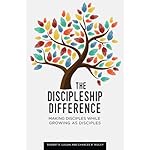Two characters, Rob and Jim, from my latest book discuss the issue of holistic discipleship as they try to lay out what the behavior of a disciple looks like in everyday life. How would you draw the diagram they’re talking through?
Rob created a diagram of discipleship, and Jim walked through it with him, trying to be sure it was holistic—including elements such as personal transformation, sacrificial service, experience of God, etc.
Rob was concerned about not losing the knowledge aspect of discipleship. “After all, I’m a seminary-trained guy. I think understanding biblical a principle is important to our character formation as disciples.”
“Of course you do,” agreed Jim. “So do I. I just think it’s important to put knowledge in the most strategically helpful place. Let me ask you this: When have you done your best research into theological questions?”
Rob thought for a minute. “When I had an important question.”
“Exactly,” said Jim. “Knowledge supports the rest of life. What we learn must be connected to how we are living, to questions we run across, to problems we face. When we have a need is when we are most truly motivated to learn. Knowledge must be integrated into our character and relationships and actions. Right living requires an intake of Scripture and the renewing of our minds.”
“So you’re saying that the most strategic place for knowledge is digging deeper when we run across questions that affect our daily living.”
“Precisely. In fact, I’m going to give you a theology assignment right now. I want you to refine this diagram you’ve created by adding some specific behaviors—subpoints, if you will—to each part of the tree. These behaviors will answer the question of what a disciple actually looks like in daily life.”
Rob again revisited the Scripture, and spent time praying and thinking about the kinds of actions that indicate someone is truly following Jesus. After some refinement and feedback from the key people in his congregation, Rob looked at his tree of discipleship diagram and stepped back. Finally, he felt he had a clear sense of what a disciple looks like—not just in knowledge, but in deeds. This is what his discipleship efforts should be aiming for.
What would your diagram look like if you were thinking through a similar question? Check out my latest book, co-authored with Dr. Charles Ridley, The Discipleship Difference, to see what our diagram looks like.
The book was recently reviewed here by Carl Simmons, who also served as our editor.
The Discipleship Difference: Making Disciples While Growing As Disciples
The Discipleship Difference lays out an intentional, holistic, and relational approach to discipleship that is individualized to meet each person wherever they are.
As an Amazon Associate I earn from qualifying purchases.
Price: $14.99


